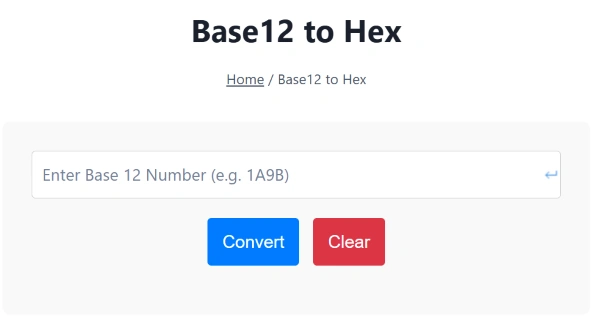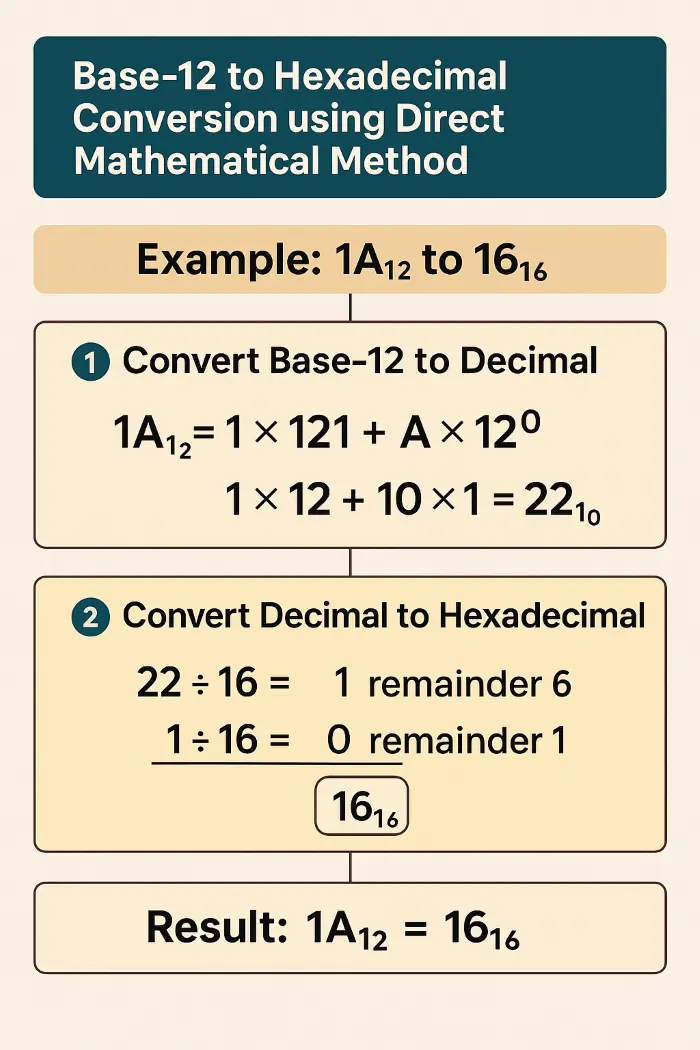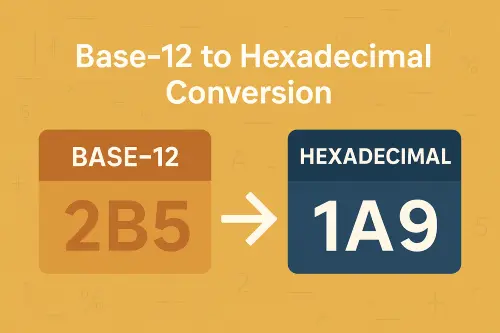Base12 to Hex
Understanding Base-12 (Duodecimal) and Hexadecimal Number Systems
The conversion between base-12 (duodecimal) and hexadecimal (base-16) represents a fundamental skill in advanced mathematics and computer science. While both systems extend beyond our familiar decimal system, each serves unique purposes in mathematical computation and digital applications.
The base12 to hex converter image is shown below:

What is the Base-12 (Duodecimal) Number System?
The base-12 or duodecimal number system uses twelve distinct digits: 0, 1, 2, 3, 4, 5, 6, 7, 8, 9, A, and B. In this system, the digit ‘A’ represents ten and ‘B’ represents eleven. Each position in a base-12 number represents a power of 12, making it particularly useful for calculations involving divisibility.
The duodecimal system offers mathematical advantages due to 12’s superior divisibility properties. Unlike base-10, which is only divisible by 2, 4, 5, and 10, the number 12 divides evenly by 2, 3, 4, 6, and 12. This property made base-12 historically significant in commerce, measurement systems, and time keeping.
Common examples of base-12 in daily life include:
- Clock faces (12 hours)
- Dozen-based counting (12 items)
- Musical scales (12 semitones)
- Imperial measurement subdivisions
To explore more numeral conversions, try the Decimal to Hex Converter.
What is the Hexadecimal (Base-16) Number System?
Hexadecimal, commonly abbreviated as “hex,” is a base-16 number system using sixteen distinct symbols: 0-9 and A-F. The letters A through F represent decimal values 10 through 15 respectively. Hexadecimal gained prominence in computing because it provides a compact way to represent binary data, with each hex digit corresponding exactly to four binary bits.
In programming and digital systems, hexadecimal appears in:
- Memory addresses and pointers
- Color codes in web development (#FF5733)
- Machine code and assembly language
- Cryptographic hash values
- Network protocols and data formats
To perform additional hex transformations, you can use the Hex to Decimal Converter, Hex to Binary Converter, or Hex Calculator for arithmetic.
Base-12 to Hexadecimal Conversion Methods

Method 1: Direct Mathematical Conversion
The most reliable approach converts base-12 numbers through decimal intermediary steps:
Step 1: Convert Base-12 to Decimal For a base-12 number with digits d₁d₂d₃…dₙ, calculate: Decimal Value = d₁×12^(n-1) + d₂×12^(n-2) + … + dₙ×12⁰
Step 2: Convert Decimal to Hexadecimal Repeatedly divide the decimal result by 16, collecting remainders in reverse order.
Use the Decimal to Hex Converter if you prefer doing step 2 automatically.
Method 2: Position-by-Position Analysis
For smaller numbers, you can analyze each position’s contribution:
- Identify each digit’s positional value in base-12
- Calculate the decimal equivalent of each position
- Sum all positional values
- Apply decimal-to-hex conversion
Practical Conversion Examples

Example 1: Simple Single-Digit Conversion
Converting B₁₂ to Hexadecimal:
- B in base-12 equals 11 in decimal
- 11 in decimal equals B in hexadecimal
- Therefore: B₁₂ = B₁₆
Example 2: Two-Digit Base-12 Number
Converting 1A₁₂ to Hexadecimal:
Step 1: Convert to decimal
- 1A₁₂ = 1×12¹ + A×12⁰
- = 1×12 + 10×1
- = 12 + 10 = 22₁₀
Step 2: Convert 22₁₀ to hexadecimal
- 22 ÷ 16 = 1 remainder 6
- Reading remainders upward: 16₁₆
Result: 1A₁₂ = 16₁₆
Example 3: Three-Digit Complex Number
Converting 2B5₁₂ to Hexadecimal:
Step 1: Convert to decimal
- 2B5₁₂ = 2×12² + B×12¹ + 5×12⁰
- = 2×144 + 11×12 + 5×1
- = 288 + 132 + 5 = 425₁₀
Step 2: Convert 425₁₀ to hexadecimal
- 425 ÷ 16 = 26 remainder 9
- 26 ÷ 16 = 1 remainder 10 (A)
- 1 ÷ 16 = 0 remainder 1
- Reading remainders upward: 1A9₁₆
Result: 2B5₁₂ = 1A9₁₆
Conversion Reference Table
| Base-12 | Decimal | Hexadecimal | Binary |
|---|---|---|---|
| 0 | 0 | 0 | 0000 |
| 1 | 1 | 1 | 0001 |
| 2 | 2 | 2 | 0010 |
| 3 | 3 | 3 | 0011 |
| 4 | 4 | 4 | 0100 |
| 5 | 5 | 5 | 0101 |
| 6 | 6 | 6 | 0110 |
| 7 | 7 | 7 | 0111 |
| 8 | 8 | 8 | 1000 |
| 9 | 9 | 9 | 1001 |
| A | 10 | A | 1010 |
| B | 11 | B | 1011 |
| 10 | 12 | C | 1100 |
| 11 | 13 | D | 1101 |
| 12 | 14 | E | 1110 |
| 13 | 15 | F | 1111 |
| 14 | 16 | 10 | 10000 |
| 15 | 17 | 11 | 10001 |
| 16 | 18 | 12 | 10010 |
| 17 | 19 | 13 | 10011 |
| 18 | 20 | 14 | 10100 |
Advanced Conversion Techniques
Handling Fractional Numbers
When converting fractional base-12 numbers to hexadecimal, apply the same principles to both integer and fractional parts separately.
Example: Converting 1A.6₁₂
Integer part: 1A₁₂ = 22₁₀ = 16₁₆ Fractional part: 0.6₁₂ = 6÷12 = 0.5₁₀ = 0.8₁₆
Result: 1A.6₁₂ = 16.8₁₆
Large Number Optimization
For large base-12 numbers, consider grouping digits and using positional shortcuts to minimize calculation errors. Breaking numbers into manageable chunks and converting each segment can improve accuracy and reduce computational complexity.
For endian-sensitive formatting, see the Little Endian Hex to Decimal Converter.
Programming Implementation
Algorithm Pseudocode
function base12ToHex(base12String):
// Step 1: Validate input
if not isValidBase12(base12String):
return "Invalid input"
// Step 2: Convert to decimal
decimal = 0
length = base12String.length
for i = 0 to length-1:
digit = base12String[i]
digitValue = convertBase12DigitToDecimal(digit)
decimal += digitValue * power(12, length-1-i)
// Step 3: Convert decimal to hexadecimal
if decimal == 0:
return "0"
hex = ""
while decimal > 0:
remainder = decimal % 16
hex = convertDecimalToHexDigit(remainder) + hex
decimal = decimal / 16
return hex
For decimal conversion steps, you can use the Hex to Decimal Converter or Decimal to Hex Converter for verification.
Error Handling Considerations
When implementing base-12 to hexadecimal conversion:
- Input Validation: Verify that input contains only valid base-12 digits (0-9, A, B)
- Overflow Protection: Handle large numbers that exceed system integer limits
- Precision Management: Maintain accuracy for fractional conversions
- Case Sensitivity: Normalize letter inputs (A/a, B/b) consistently
You can also test patterns using the Hex Bitwise Calculator for deeper numeric analysis.
Real-World Applications
Mathematical Research
Base-12 to hexadecimal conversion appears in number theory research, particularly in studies involving:
- Modular arithmetic systems
- Divisibility properties across different bases
- Computational efficiency comparisons
- Abstract algebra applications
Computer Science Applications
While direct base-12 to hex conversion is less common in everyday programming, it occurs in:
- Specialized mathematical software
- Educational programming tools
- Custom numeral system implementations
- Algorithm design and analysis
Educational Contexts
Teaching base-12 to hexadecimal conversion helps students understand:
- Positional notation principles
- Number system relationships
- Mathematical abstraction concepts
- Computational thinking skills
Common Conversion Mistakes and Solutions
Mistake 1: Digit Value Confusion
Problem: Confusing A and B values between different bases Solution: Always verify that A=10 in base-12 and A=10 in hexadecimal, B=11 in base-12
Mistake 2: Positional Calculation Errors
Problem: Incorrect power calculations in positional notation Solution: Double-check positional values; rightmost position is always power 0
Mistake 3: Incomplete Decimal Conversion
Problem: Stopping conversion process before reaching zero Solution: Continue division process until quotient equals zero
Tools and Resources for Base-12 to Hexadecimal Conversion
Online Calculators
Modern online conversion tools provide instant base-12 to hexadecimal conversion with features including:
- Batch conversion capabilities
- Step-by-step solution displays
- Multiple format outputs
- Accuracy verification systems
For comprehensive hexadecimal calculation on converted values, specialized hexadecimal calculators offer arithmetic operations, bitwise functions, and additional base conversions.
Also, you can choose hex conversion tool below to directly visit that specific page:
Educational Software
Mathematical software packages often include base conversion modules supporting:
- Interactive conversion tutorials
- Visual representation tools
- Practice problem generators
- Progress tracking systems
Verification and Accuracy Checking
Cross-Verification Method
Always verify conversions using reverse calculation:
- Convert your hexadecimal result back to decimal
- Convert the decimal back to base-12
- Compare with original base-12 input
Multiple Method Comparison
Use different conversion approaches to confirm results:
- Direct mathematical conversion
- Position-by-position analysis
- Online calculator verification
- Programming implementation
FAQs — Base-12 to Hex Conversion
Q1: Why might one prefer base-12 over base-10 in some calculations?
A1: Base-12 offers better divisibility properties than base-10, making it easier to work with fractions and divisors common in measurement and timekeeping, although this is more relevant outside typical programming contexts.
Q2: Are there any challenges with implementing base-12 arithmetic in common programming languages?
A2: Yes, since base-12 is not natively supported, programmers must implement custom handling for digit validation, conversion logic, and arithmetic operations, often relying on string manipulation and manual base conversions.
Q3: How can floating-point errors affect fractional base-12 to hex conversions?
A3: Fractional conversions may suffer from rounding errors due to differences in base representation and floating-point precision limitations, so careful handling or arbitrary precision libraries might be needed for high accuracy.
